We’ve all experienced the situation. There you are, relaxing in the shower after a long day at work, throwing in a load of dirty clothes in the laundry room, or getting ready to cook your family dinner, and boom, you notice that there’s mold in caulk. Specifically, the caulk directly in your line of sight that you’re staring down right at that moment. It’s just an annoying fact of life that ties us all together with the common response of, “Ugh, really?”

This annoyance that always seems to pop up at the worst time (like when the in-laws are literally on their way to your home) isn’t one that we should take lightly. Even if it is a common problem. Not only is mold in caulk an eyesore, but it’s also not stellar for your health. Any form of mold exposure in your home can cause a long list of adverse health reactions.
That’s why that moldy caulk fiasco has got to go.
Here’s what you can do to prevent mold in caulk and what to do if this fungus among us manages to sneak in.
Because it’s not just annoying, it’s bad news for our home health.
THE INDOOR ENEMY: MOLD
In nature, the 100,000 species of mold identified so far are a pillar of the natural world. Mold ensures that natural processes like decomposition run smoothly. When this type of fungus moves into our homes, though, that’s when it becomes decidedly less helpful and U-turns into a health hazard.
Every species of mold reproduces by creating microscopic spores that are released into the air.¹’² Picture a dandelion puff releasing those fluffy white seeds, and you’ve got the right idea. These spores fly all over the place, daydreaming about finding a moldy home to call their own. Like a seed, these spores are not alive and will remain in spore-form until they find a surface that has the components they need to transition into the world of the living.
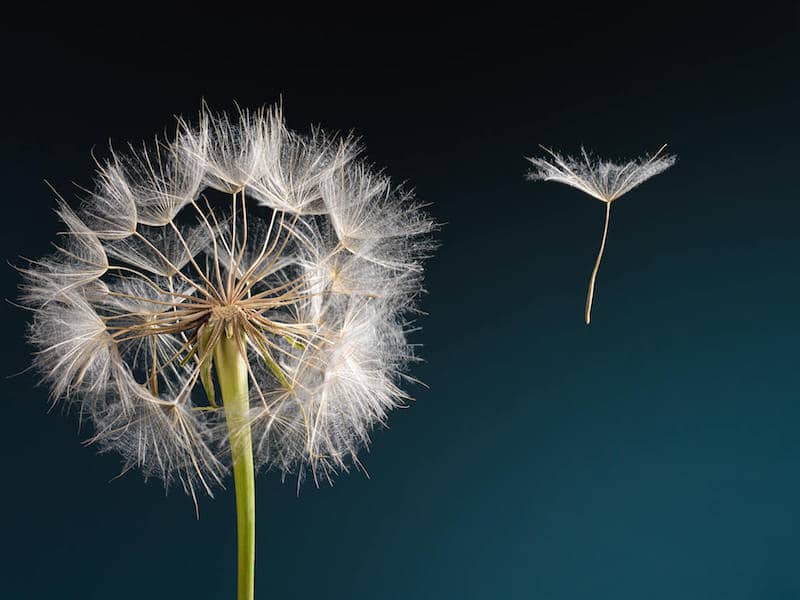
Exactly like a plant.
All it takes for a spore to survive and thrive are four simple ingredients.³
THESE INGREDIENTS ARE:
- Oxygen: They require very little, which is why they can live in walls
- Food: They eat almost anything, like dust and organic matter
- Temperature: Most prefer 40-90 degrees Fahrenheit, but some can live in extremes
- Moisture: The often missing component
If the perfect storm occurs and all of these are present for 24–48 hours, that spore will turn into a living, growing, reproducing mold colony.
THE INDOOR FACTOR
Why are issues such as mold in caulk bad news for a home? When mold releases spores in nature, there’s a huge area for them to disperse into—it’s a big, wide world out there! However, when there’s mold in a home, continually shooting off spores like a confetti cannon at a music festival, all of those particles remain trapped within the walls of the home.
With how homes are built nowadays to promote energy efficiency, there’s little airflow between inside air and outside air. That leads to all of the moldy particles remaining inside the building, floating around that indoor space and landing on whatever surface they come into contact with. That’s why issues such as mold in caulk are indoor air quality and contamination nightmares.
Some species of mold can also release microscopic toxins called mycotoxins, adding to the particle party hanging out in your home.⁴ The more toxic particles there are floating around, the worse it is for the health of those living inside.
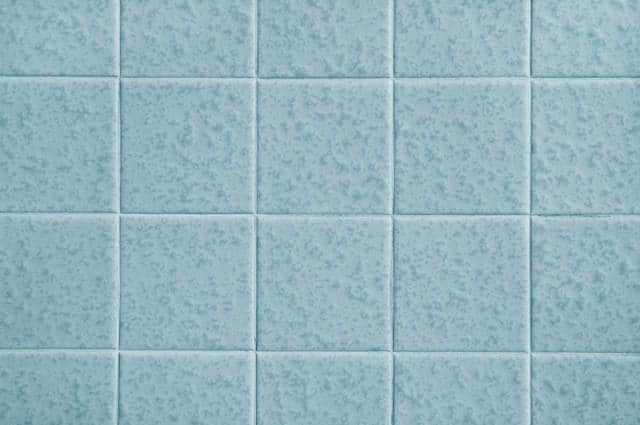
MOLD IN CAULK, THOUGH?
When you think about it, caulking can be the ideal moldy home.
HERE ARE A FEW REASONS WHY:
- It’s usually in moisture-rich rooms like the bathroom, kitchen, and laundry room.
- There is an abundance of yummy particles to eat (including the caulk itself).
- The temperature is nice and balmy.
- Cleaning doesn’t always occur as often as it should.
- Mistakes, such as misaligned tiles and poor caulking practices, happen all the time.
If a lucky mold spore happens upon the caulk, it will think it has won the lottery.
MOLD IN CAULK IS THE BODY’S NEMESIS
With so many species of mold out there and spores’ ability to hitch a ride on the air current to pretty much anywhere, it’s impossible to completely avoid them. The key here is their size. Since they’re so small, they can shoot right into your nose and mouth and make their way into your body.
The EPA classifies these teeny-tiny specks as particulate matter and breaks them down into two categories, both of which are inhalable.⁵
THOSE CATEGORIES ARE:
- PM10: particles that have a diameter of around 10 micrometers or less.
- PM2.5: fine particles that have a diameter of around 2.5 micrometers or less.
Inhaling a few spores or mycotoxins throughout the day triggers the body to deploy the immune system to kick them to the curb ASAP. When you’re living in a house with a thriving colony, though, that’s a significantly higher number of particles to fight. It’s like living in a bubble full of moldy particles and continually breathing in that icky air.
Considering that you breathe an average of 20,000 breaths a day (and most of us spend a significant amount of time at home), that’s a serious task for the immune system.⁶ It will attempt to keep up with the onslaught, but it can eventually get bogged down and malfunction. This can lead to a variety of symptoms and leaves the door wide open for other conditions to take hold, like Lyme disease and psoriasis.

COMMON SYMPTOMS OF MOLD EXPOSURE INCLUDE:
- Runny nose
- Watery eyes
- Respiratory issues
- Rashes
- Hair loss
- Digestive problems
- Brain fog
- Chronic fatigue
- Neurological issues
- Sleeping problems
At the end of the day, everyone responds to mold growth differently. Factors such as genetics, preexisting conditions, species of mold, presence of mycotoxins, and length of exposure all play a role.⁶’⁷’⁸’⁹ While one person may only develop the occasional respiratory infection, another may suffer from over 30 symptoms.
The potential health impact is why any growth, even mold in caulk, should be dealt with quickly and correctly. Or, prevent it from occurring in the first place!
MOLD IN CAULK: HOW TO CORRECTLY HANDLE THE SITUATION
If you’re staring down at that unsightly image of mold in caulk, you need a solid action plan on how to get rid of it. With all of the misinformation out there, though, you could be scratching your head. Let’s clear that up.
First things first, do NOT use bleach!¹⁰ This harsh chemical does not make the cut when it comes to battling mold.
The ultimate goal in tackling mold in caulk is to ensure all of the contamination is gone. Killing mold and leaving particles behind or only removing the visible portion is a no-go for home health.
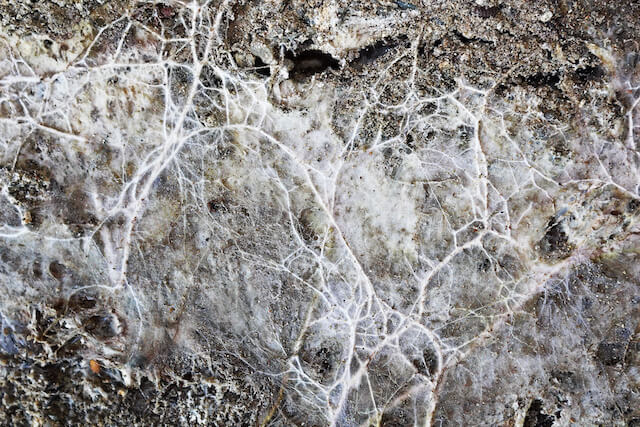
TOTAL REMOVAL IS IMPORTANT FOR A COUPLE OF REASONS.
- When mold grows, it puts down roots called hyphae that penetrate deep into the surface it’s growing on.
- Spores and mycotoxins are so small that they can embed themselves within the surface the mold colony is living on. Caulk, specifically, becomes semi-porous to porous as it ages, leaving enough space for these particles to make their way inside.
- Proper remediation involves removing all of the contaminants present. Otherwise, exposure will continue.
Hence why knowing how to completely remove that contamination is key!
HERE ARE THE STEPS TO REMOVING MOLD IN CAULK:
- Put on your protective gear (masks and gloves)
- Fill a spray bottle with 8% hydrogen peroxide
- Spray on the surface and let it sit for at least 10 minutes
- Wipe away with a microfiber towel
- Complete the process at least three times to ensure mycotoxins and bacteria (if present) are removed
If the mold comes right back immediately, that’s when you’re going to need to pull out the big guns and recaulk. Is it a pain? Yes! Will help ensure that your indoor environment is safe and that the mold problem is actually gone? Also yes.
So, if that mold comes right back, remove the current caulk, clean using the steps above, and then recaulk the entire area.
Also, make sure to read the manufacturer’s instructions on the caulk! It will tell you the proper application directions and how long to leave the caulk to dry so it can act as a protective barrier.
THE MOLD CAME BACK… AGAIN…
If you replace the caulk but that mold pops right back up, it could indicate a much bigger issue. The baseboard behind the caulk could be wet, or there could be wonky tiles and/or improper grouting, leading to a permanently wet environment. A wet environment is a habitable home for mold.
In this scenario, it’s best to call in a professional mold inspector and see what the issue is. The mold could be growing deep within the wall and needs to be removed, or a hidden mold problem could be elsewhere in the home. The more spores there are in the indoor environment, the higher the chances are that they’ll stumble on other habitable areas like your caulk.
If you notice some structural issues, a mold inspector is still a good idea just to make sure there’s no hidden mold. The faster you catch an issue, the less contamination there will be and the lower the health impact. Not to mention, it can help save money during costly remediation.
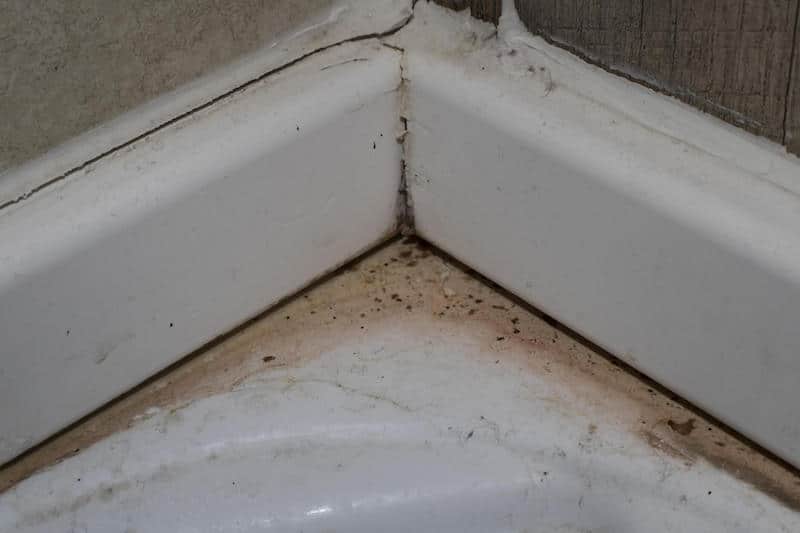
WHAT IF THERE’S MOLD BEHIND CAULK?
Keep an eye out while you’re recaulking. If you see that the wall behind the caulk is wet or if mold is growing behind the caulk, that could indicates a larger issue. Mold could be growing inside the wall, which is a much bigger deal than simply mold in caulk.
In these instances, you can try to remediate the mold using the same steps as above, but it’s always best to call in a professional. First of all, you never know how deep that mold colony penetrated. You need an inspector to come in and assess the situation, and then a remediation team that can come in and properly remove all of the contamination. Secondly, the source of that water problem needs to be fixed. Whether it’s improper ventilation, insulation issues, a leak, whatever, it needs to be solved or the mold can just come right back.
Again, the ultimate goal when dealing with mold in caulk is that all of that contamination is gone and stays gone. A safe home environment is one without moldy particles floating all around.
HOW TO PREVENT MOLD IN CAULK
The best way to handle mold in caulk is to prevent it from happening in the first place. Avoidance not only saves you time and money but also helps promote healthy living by maintaining safe indoor air quality and a clean living environment. One problem can easily turn into multiple mold factories throughout a home as the spores opportunistically find other habitable areas to colonize.
Here are some steps to take to prevent mold in caulk.
CLEANING
No one loves cleaning, but mold especially hates it. Cleaning removes rogue mold spores that are hanging around and gets rid of food sources like dust and other organic matter. But, once again, do not use bleach! For solid caulk decontamination, grab some safety gear and then spray it down with 8% hydrogen peroxide. Let it sit for at least 10 minutes, and then wipe with a microfiber towel.
Hydrogen peroxide can penetrate semi-porous surfaces and bring any particles (like mold spores) up to the surface, and microfiber towels are 100 times better at removing tiny particles than regular rags. Adding this to your weekly cleaning regime can work wonders to prevent mold.
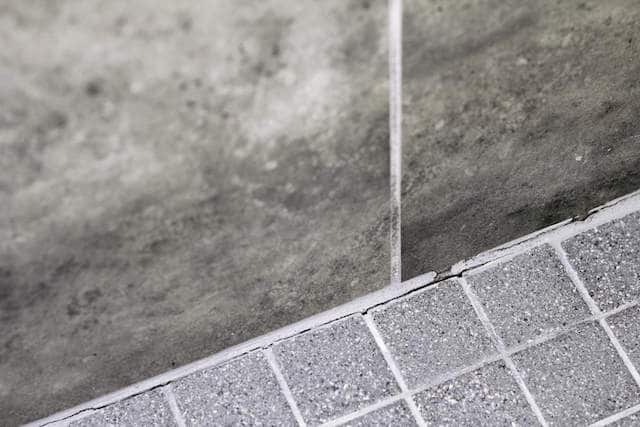
STRUCTURAL INTEGRITY
As mentioned earlier, misaligned tiles and bad caulking jobs can lead to serious moisture problems. Any gaps or holes can let in water and trap yummy particles like dust, all of which can lead to mold growth.
Fixing the issues preventatively can help avoid a moldy catastrophe from occurring in the first place.
KEEPING UP WITH THE CAULK-DASHIANS
Unfortunately, caulk doesn’t last forever. Typically, the average lifespan is around five years, so make sure to set a timer and schedule in time to replace the old with the new. When caulking ages, it becomes more and more permeable, and it can begin to break down and leave gaps. As we now know, that can quickly lead to mold in caulk and a rapid remediation response.
Regularly inspect the caulk in your home as well. Even if it’s not at the five-year mark, wear and tear happens. If you see any cracks, gaps, or tears, go ahead and replace the existing caulk.
WAGE WAR ON MOISTURE
One of the best ways to prevent mold in caulk is to reduce the wet factor in the often moisture-rich rooms it’s found in.
THIS CAN BE ACCOMPLISHED IN A VARIETY OF WAYS:
- Turn on exhaust fans when using the room
- While showering, crack a window or door to promote airflow
- Wipe up any spills immediately
- Keep windows and doors closed on rainy and/or humid days
- Squeegee the shower after use
- Invest in a dehumidifier
- Maintain indoor humidity levels between 30-50%¹¹
This isn’t an exhaustive list, but tackling a few steps at a time can help ensure mold doesn’t get the chance to grow in your home.
A SAFE HOME ENVIRONMENT
At the end of the day, mold in caulk is annoying, but it’s a common occurrence that we all need to know how to handle properly and attempt to prevent. Our homes are supposed to be our safe spaces, but when they’re filled with moldy particles, they can become toxic zones that tank our health.

It’s just not something we often think about because society rarely considers indoor mold growth and air quality.
Keeping yourself and your family safe and healthy means focusing on building more awareness and actively working on maintaining a contaminant-free home. It may seem daunting at first, but don’t stress! A healthy home is accomplished by tackling one preventative step at a time. In this case, it’s avoiding mold in caulk and having a plan in place should this moldy debacle ever occur.
Little actions such as this add up to a safer and cleaner indoor space for you and your family. Which, is the ultimate goal! And, when in doubt, call a professional to get some advice.
Health begins at home.™
Still Have Questions?
A member of our team is here to help! Click on “Get Started ➤” below to book a consultation with a member of the HOMECLEANSE team. We have a few quick questions that will help us put together a roadmap to solve or prevent all of your mold problems.
Two minutes of your time could lead to better health for you and your family.
" " indicates required fields
- Environmental Protection Agency. (n.d.). Mold. EPA. Retrieved from https://www.epa.gov/mold.
- Centers for Disease Control and Prevention. Basic facts about mold and dampness. Centers for Disease Control and Prevention. Retrieved from https://www.cdc.gov/mold/faqs.htm.
- Lstiburek, J., Brennan, T., & Yost, N. (2002, January 15). Rr-0208: What you need to know about mold. Building Science Corporation. Retrieved from, https://www.buildingscience.com/documents/reports/rr-0208-what-you-need-to-know-about-mold/view.
- World Health Organization. (n.d.). Mycotoxins. World Health Organization. Retrieved from https://www.who.int/news-room/fact-sheets/detail/mycotoxins.
- EPA. (n.d.). Health and Environmental Effects of Particulate Matter (PM). EPA. Retrieved October 8, 2021, from https://www.epa.gov/pm-pollution/health-and-environmental-effects-particulate-matter-pm.
Environmental and Occupational Health Assessment Program, & - Environmental and Occupational Health Assessment Program, & Health Science Section, Mold Basics for Primary Care Clinicians (2009). Hartford, CT; Connecticut Department of Public Health. , H. S. S., Mold Basics for Primary Care Clinicians 1–10 (2009). Hartford, CT; Connecticut Department of Public Health.
Curtis, L., Lieberman, A., Stark, M., Rea, W., & Vetter, M. (2004). Adverse health effects of indoor molds. Journal of Nutritional & Environmental Medicine, 14(3), 261-274. - Bush, R. K., Portnoy, J. M., Saxon, A., Terr, A. I., & Wood, R. A. (2006). The medical effects of mold exposure. Journal of Allergy and Clinical Immunology, 117(2), 326-333
- Fisk, W. J., Lei-Gomez, Q., & Mendell, M. J. (2007). Meta-analyses of the associations of respiratory health effects with dampness and mold in homes. Indoor air, 17(4), 284-296.
- EPA. (n.d.). Should I use bleach to clean up mold? EPA. Retrieved from https://www.epa.gov/mold/should-i-use-bleach-clean-mold.
- Brown, A. (2014, April 28). How Many Breaths Do You Take Each Day? [web log]. Retrieved from How Many Breaths Do You Take Each Day?
- EPA. (n.d.). A Brief Guide to Mold, Moisture, and Your Home. EPA. Retrieved from https://www.epa.gov/mold/brief-guide-mold-moisture-and-your-home#tab-6.
Must-Have Indoor Air Quality Tools
-

EC3 Laundry Additive
$23.00 SHOP NOWAdd EC3 to every rinse cycle to rinse away mold, bacteria and musty odors from...
-
Sale

Intellipure Compact Air Purifier
Buy one Compact, get one free. Simply add one to your cart, and a second...
4 interest-free payments or as low as $18/mo with Affirm. Check your purchasing power
Original price was: $299.00.$199.00Current price is: $199.00. SHOP NOW -

Intellipure SuperV Whole House Air Purifier
Turn your HVAC into a filtration system, removing 99% of ultrafine particles including airborne mold,...
Starting at $70/mo or 0% APR with Affirm. Check your purchasing power
$2,000.00 – $2,995.00 SHOP NOW -

HomeCleanse Cleaning
Take your cleaning to the next level buying all the tools we use to keep...
-
$299.00 – $549.00 SHOP NOW -

Mold & Bacteria Contents Cleaning
Remove harmful pollutants that accumulate in the dust of your home. (Options available for renters...
4 interest-free payments of $25 with Affirm. Check your purchasing power
$99.00 – $349.00 SHOP NOW -

EC3 Mold Solution Concentrate
$33.00 SHOP NOWMicro Balance EC3 Mold Solution Concentrate is a natural botanical that removes mold spores, bacteria,...
-
Sale

Industry-Leading Intellipure Ultrafine 468
The Intellipure® Ultrafine 468 features our proprietary DFS technology, which traps and eliminates potentially harmful...
Starting at $46/mo or 0% APR with Affirm. Check your purchasing power
Original price was: $999.00.$499.00Current price is: $499.00. SHOP NOW -

The Dust Test
The Dust Test is a comprehensive at-home test that helps you identify mold and toxins...
Starting at $25/mo or 0% APR with Affirm. Check your purchasing power
$274.00 SHOP NOW -
Sale

EuroClean 4 Gallon Hepa Vacuum
The Euroclean GD930HSP is a 4 Gallon Dry HEPA Vacuum that meets the EPA's standards...
Starting at $56/mo or 0% APR with Affirm. Check your purchasing power
Original price was: $849.00.$619.00Current price is: $619.00. SHOP NOW -

AprilAire E080 Professional Dehumidifier Bundle
Includes all the dehumidifier accessories you will need. Our Aprilaire E080 comes with a drain...
Starting at $94/mo or 0% APR with Affirm. Check your purchasing power
$1,499.99 SHOP NOW
